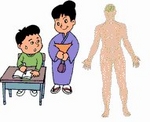
Worksheets and No Prep Teaching Resources
Reading Comprehension Worksheets
Nervous System

Nervous System
 Worksheets and No Prep Teaching Resources Reading Comprehension Worksheets Nervous System |
 Nervous System |
| edHelper's suggested reading level: | grades 5 to 6 | |
| Flesch-Kincaid grade level: | 6.38 |
|
The Brain and Spinal Cord
By Jennifer Kenny |

|
 1 Your body's nervous system has many important jobs. It can also be divided into three categories. The central nervous system, or CNS, is made up of the brain and spinal cord. It is the center of your body and the center of control and coordination. The peripheral nervous system, or PNS, includes the nerves that reach the outer parts of your body. Finally, the autonomic nervous system, or ANS, includes the nerves that are near the center part of your body. The ANS is actually a smaller part of the PNS. The ANS controls the automatic processes.
1 Your body's nervous system has many important jobs. It can also be divided into three categories. The central nervous system, or CNS, is made up of the brain and spinal cord. It is the center of your body and the center of control and coordination. The peripheral nervous system, or PNS, includes the nerves that reach the outer parts of your body. Finally, the autonomic nervous system, or ANS, includes the nerves that are near the center part of your body. The ANS is actually a smaller part of the PNS. The ANS controls the automatic processes. |
Create Weekly Reading Books
Prepare for an entire week at once! |
| Leave your feedback on The Brain and Spinal Cord (use this link if you found an error in the story) |
 |
Nervous System
|